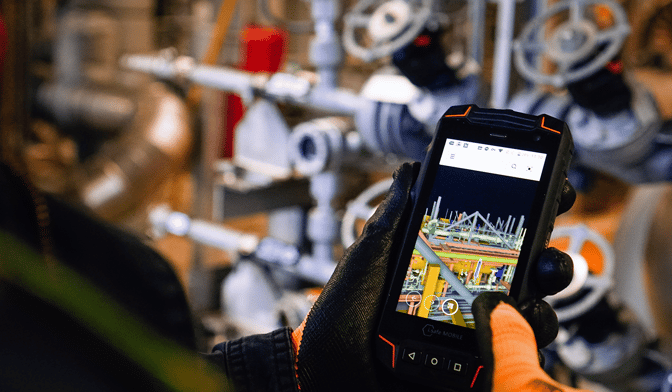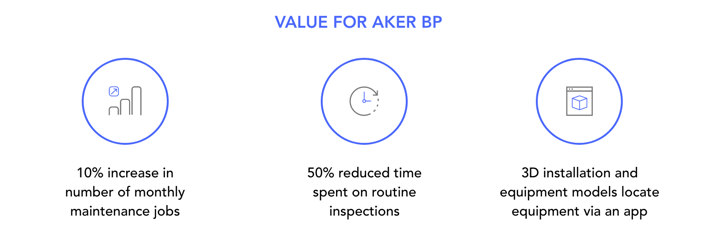
Digital transformation presents a game-changing opportunity for downstream operators to improve yield productivity, asset reliability, and workforce effectiveness. Refiners need to sharpen their digital capabilities in three critical areas: field force effectiveness, analytics in production, and asset management.
Large-scale digitization will only be possible if companies make all the data they collect available in a way that’s intuitive to human users and machines.
Data trapped in complex, siloed systems presents a key challenge to extracting useful insights or building analytic applications.
This article explains how to accelerate field force effectiveness, which is one of many critical areas that can be radically improved by Cognite’s products. The key driver to workforce enablement is equipping operators with updated, contextualized data that reveals insights into operations and empowers them to make data-driven decisions.
Limited access to data limits field workers’ productivity while exposing them to greater risks
![]() Refineries tend to have a huge backlog of maintenance orders, and operations and maintenance teams usually perform a risk assessment of the complete set of tasks planned for the following day to ensure work can be executed safely and efficiently. Data about work permits, operational risk assessments, and temporary deviations are stored in separate systems, meaning members of the team spend much of their time before and during meetings on accessing and compiling information that is not readily available.
Refineries tend to have a huge backlog of maintenance orders, and operations and maintenance teams usually perform a risk assessment of the complete set of tasks planned for the following day to ensure work can be executed safely and efficiently. Data about work permits, operational risk assessments, and temporary deviations are stored in separate systems, meaning members of the team spend much of their time before and during meetings on accessing and compiling information that is not readily available.
Due to the sheer size of refineries, uncertainty about where specific equipment is located, and inaccessible data, maintenance workers spend unnecessary time traveling back and forth between different locations and have a skewed representation of the actual risk related to maintenance activities.
A single maintenance task may require an onsite operator to access several separate systems to get the required data. Sometimes they must request additional permissions to get access. Too much time is wasted hunting for information across many different systems and printing it out for use in the field.
Read more: Downstream Digitalization: Get a closer, smarter look at your maintenance activities
![]() In addition to technological obstacles, there is the human element. Factors affecting risk exposure and planning such as a deviation that was observed during the day -- a spill or a piece of equipment emitting a strange noise, for example – has to be entered manually in today’s system, meaning that someone has to remember to include it, or to bring it up during meetings. Given the amount of work, complexity, and sometimes limited system support, it is possible that safety concerns could slip through the cracks.
In addition to technological obstacles, there is the human element. Factors affecting risk exposure and planning such as a deviation that was observed during the day -- a spill or a piece of equipment emitting a strange noise, for example – has to be entered manually in today’s system, meaning that someone has to remember to include it, or to bring it up during meetings. Given the amount of work, complexity, and sometimes limited system support, it is possible that safety concerns could slip through the cracks.
Without a unified enablement and integration layer, the relevant contextualized data can’t be accessed from one place. Integrating data from different sources requires personnel with specialized skill sets along with a major investment in building custom extractors for each data source.
These challenges are born out of rigid data architectures that were not designed with an open, holistic view of enabling data utilization for models and applications. The good news? Rigid data structures can be fixed with Cognite Data Fusion®, which creates holistic data models that can be accessed through APIs, high-quality SDKs, connectors, and plugins to help operators use the applications they find the best suited to their needs.
Empower field workers by giving them access to data
Cognite’s products help liberate data from siloed IT and OT systems, and contextualize it for easier creation and deployment of analytics models and business applications. With contextualized data as a service, downstream operators and workers no longer need to collect, clean, and contextualize data for every new data science project or new business application.
For Aker BP, one of the largest independent oil companies in Europe, Cognite’s products have helped increase plant workers’ safety while increasing their productivity.
In one example, Cognite fed data from work permits, leaks, barrier impairments, well integrity status, noise levels, and more into Cognite Data Fusion®. Cognite’s developers then made this data, as well as 3D models and equipment tags, available to field workers in InField, Cognite’s flagship Digital Worker application, in order to help the company speed up visual inspection and testing of various equipment.
InField runs on top of Cognite Data Fusion® and is accessible on computers and mobile devices. The application enables engineers and technicians to instantly access all live sensor data and historic equipment performance data with less than one second delay, find essential documentation (e.g., procedures, work orders, drawings, P&IDs and maintenance logs), interact with 3D models of installation and equipment, share pictures and notes with their crew, and use computer vision to locate equipment tags and automatically provide related information.
Aker BP used InField to boost worker safety by giving its offshore management team a clear overview of factors that affect safe execution of upcoming maintenance tasks. The application boosted awareness of risk factors and reduced time spent preparing for meetings by combining data about work permits, barrier impairments, leaks, noise levels and asset integrity status. The solution also helped the company fulfil its regulatory responsibilities and expedited risk assessment during meetings.

In another example, Aker BP used data in Cognite Data Fusion® to improve its maintenance routines for process shutdown (PSD) valves. By giving field workers the ability to see equipment tags in context with other information -- specifically, 3D models of the equipment -- Aker BP was able to reduce annual maintenance checks by 66% and cut the time of an average maintenance session by 50%.
These are just two examples of how improved access to data can benefit field workers. Increasing the overall safety of the refinery by providing tools and systems to the operators and maintenance personnel for better monitoring of assets can cut costs, reduce waste, and improve plant uptime.
Curious if Cognite Data Fusion® can help your organization? Book a free demo here.
This post is an excerpt from the white paper Downstream Digitalization.